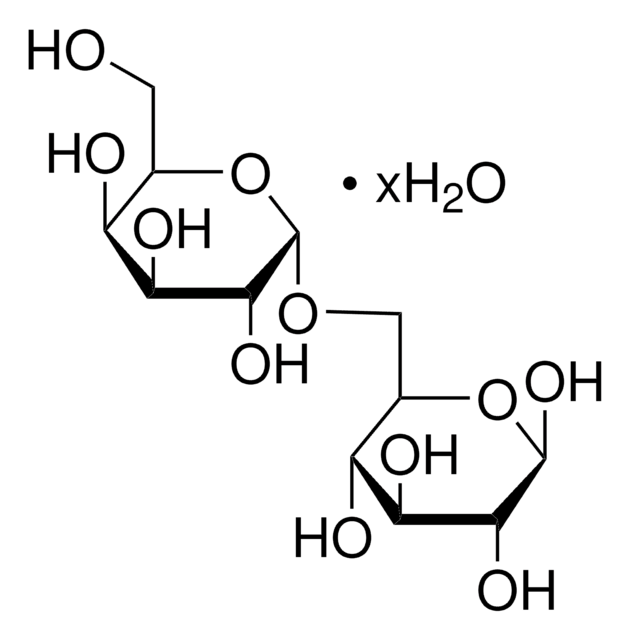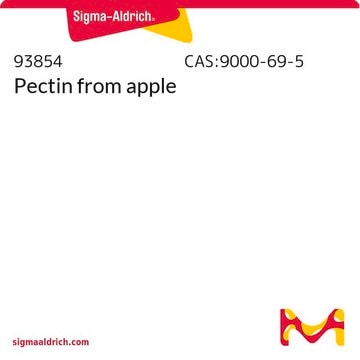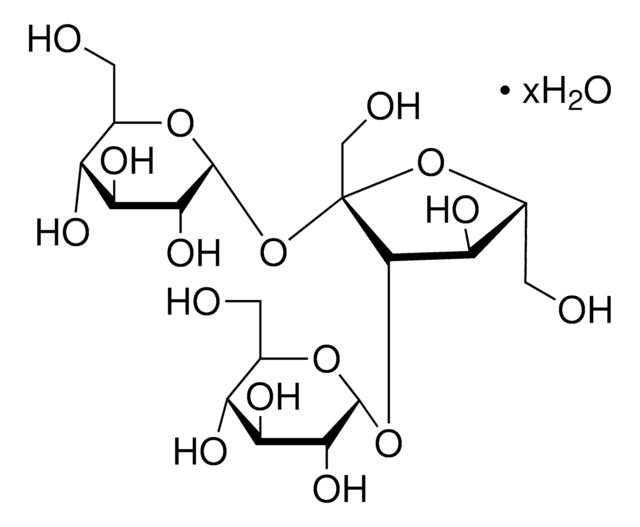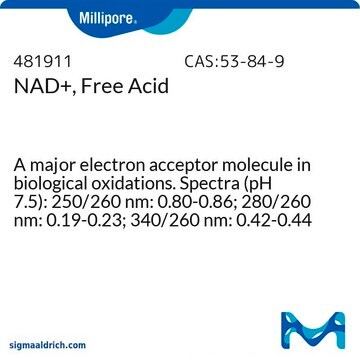63630
D-(+)-Melibiose
suitable for microbiology, ≥99.0%
Synonyme(s) :
Raffinose, Melizitose, α-D-Galactosyl-(1→6)-α-D-glucopyranoside, Galactosyl D-glucose, Galactosylglucose, D-Galactopyranosyl-(1→6)-D-glucose, Melibiose, Galactinol, D-(+)-Galactosyl-(1→6)-D-(+)-glucose, α-D-Gal(1→6)β-D-Glc, 6-O-α-D-Galactopyranosyl-D-glucose
About This Item
Produits recommandés
Niveau de qualité
Pureté
≥99.0% (HPLC)
≥99.0%
Forme
powder
Activité optique
[α]20/D +137±3°, 10 hr, c = 5% in H2O
Conditionnement
pkg of 10 g
pkg of 50 g
Résidus de calcination
≤0.1% (as SO4)
Couleur
colorless to white
Solubilité
H2O: 0.1 g/mL, clear, colorless
Traces d'anions
chloride (Cl-): ≤50 mg/kg
sulfate (SO42-): ≤200 mg/kg
Traces de cations
As: ≤0.1 mg/kg
Ca: ≤500 mg/kg
Cd: ≤5 mg/kg
Co: ≤5 mg/kg
Cr: ≤5 mg/kg
Cu: ≤5 mg/kg
Fe: ≤10 mg/kg
K: ≤50 mg/kg
Mg: ≤10 mg/kg
Mn: ≤5 mg/kg
Na: ≤50 mg/kg
Ni: ≤5 mg/kg
Pb: ≤5 mg/kg
Zn: ≤5 mg/kg
Application(s)
microbiology
Chaîne SMILES
OC[C@H]1O[C@H](OC[C@@H](O)[C@@H](O)[C@H](O)[C@@H](O)C=O)[C@H](O)[C@@H](O)[C@H]1O
InChI
1S/C12H22O11/c13-1-4(15)7(17)8(18)5(16)3-22-12-11(21)10(20)9(19)6(2-14)23-12/h1,4-12,14-21H,2-3H2/t4-,5+,6+,7+,8+,9-,10-,11+,12-/m0/s1
Clé InChI
AYRXSINWFIIFAE-GFRRCQKTSA-N
Vous recherchez des produits similaires ? Visite Guide de comparaison des produits
Description générale
Application
Stockage et stabilité
Code de la classe de stockage
11 - Combustible Solids
Classe de danger pour l'eau (WGK)
WGK 3
Point d'éclair (°F)
Not applicable
Point d'éclair (°C)
Not applicable
Équipement de protection individuelle
Eyeshields, Gloves, type N95 (US)
Choose from one of the most recent versions:
Déjà en possession de ce produit ?
Retrouvez la documentation relative aux produits que vous avez récemment achetés dans la Bibliothèque de documents.
Les clients ont également consulté
Articles
Culture media provides a habitat with suitable nutrients, energy sources, and certain environmental conditions for the growth of microorganisms. The components of the culture media range from simple sugars to peptones, salts, antibiotics, and complex indicators.
Notre équipe de scientifiques dispose d'une expérience dans tous les secteurs de la recherche, notamment en sciences de la vie, science des matériaux, synthèse chimique, chromatographie, analyse et dans de nombreux autres domaines..
Contacter notre Service technique











